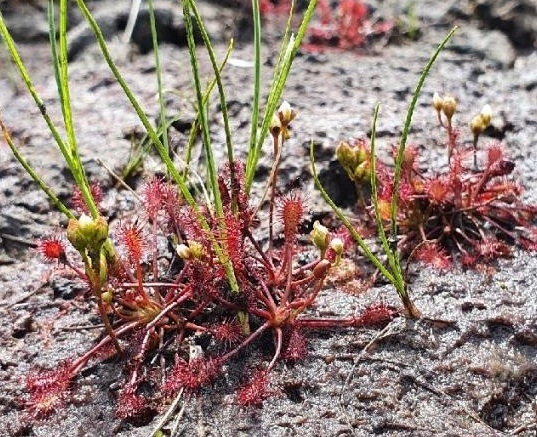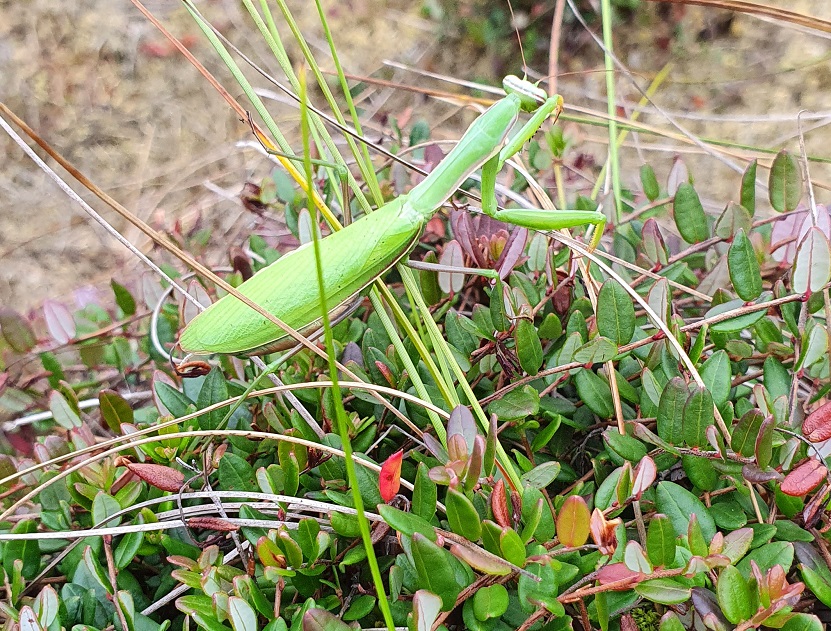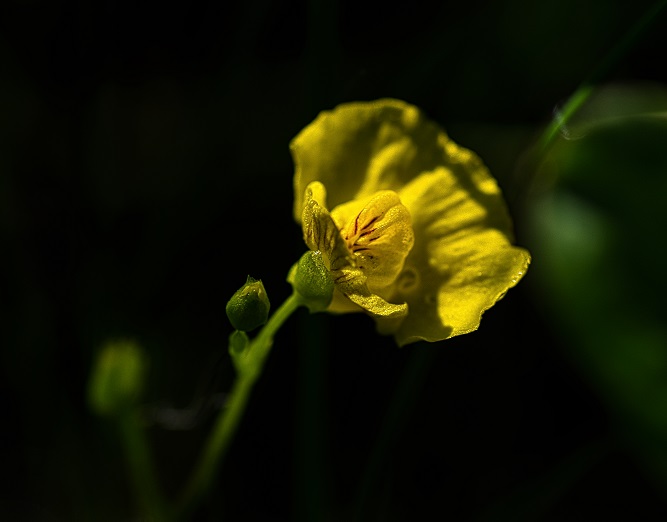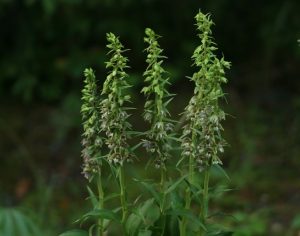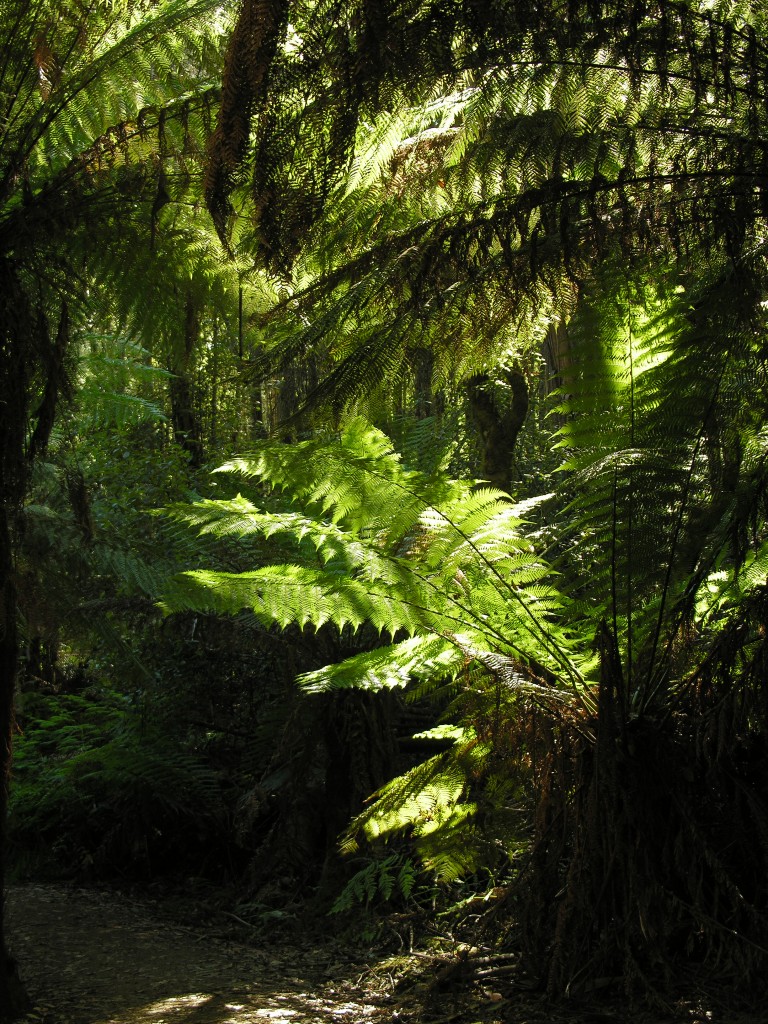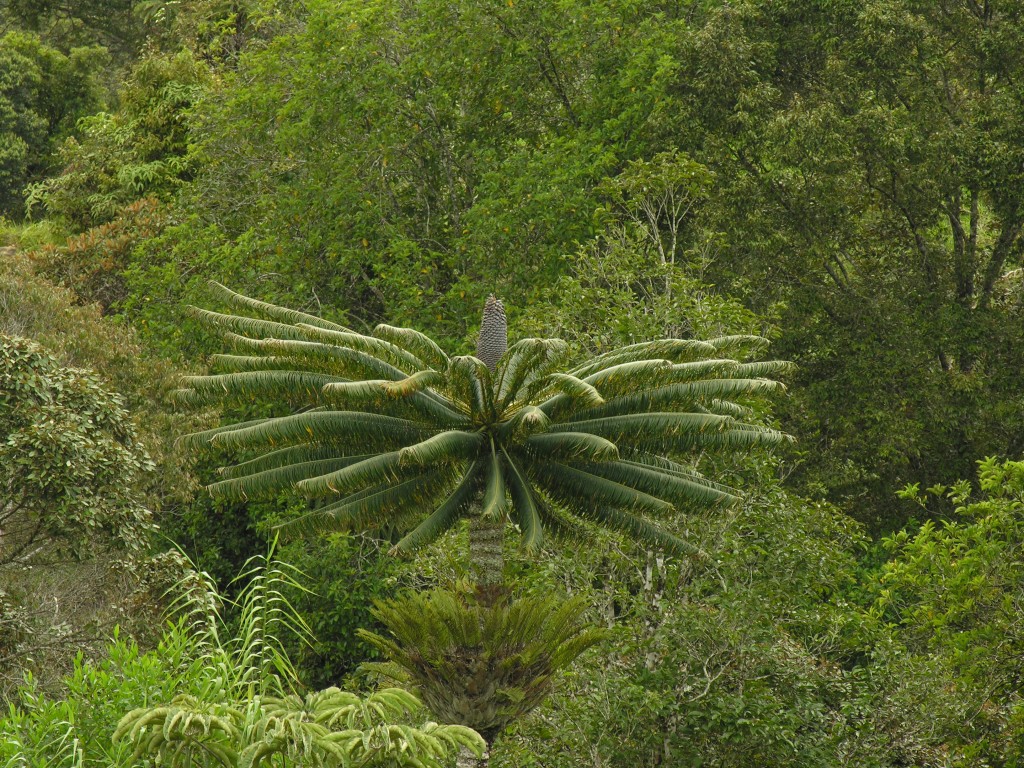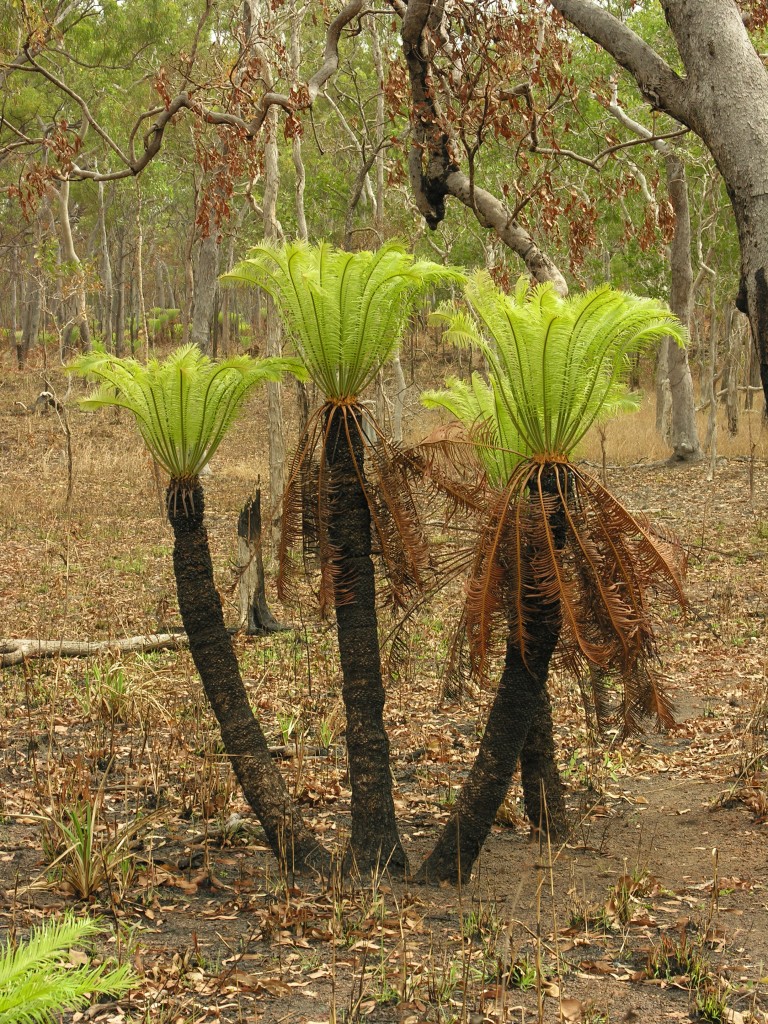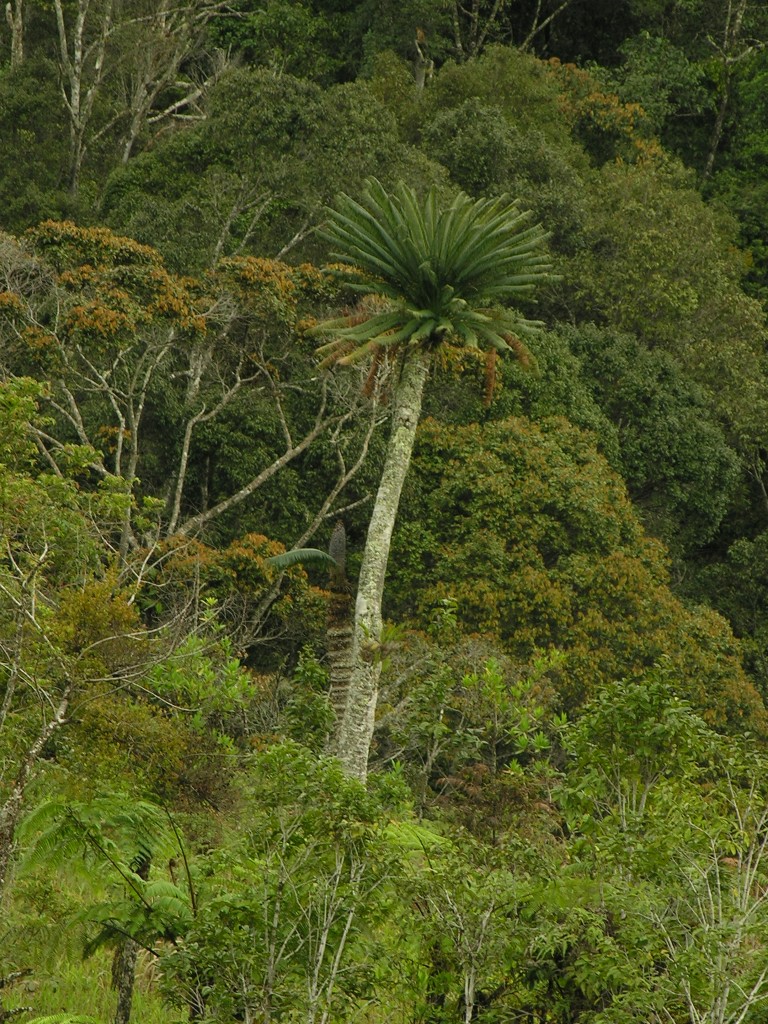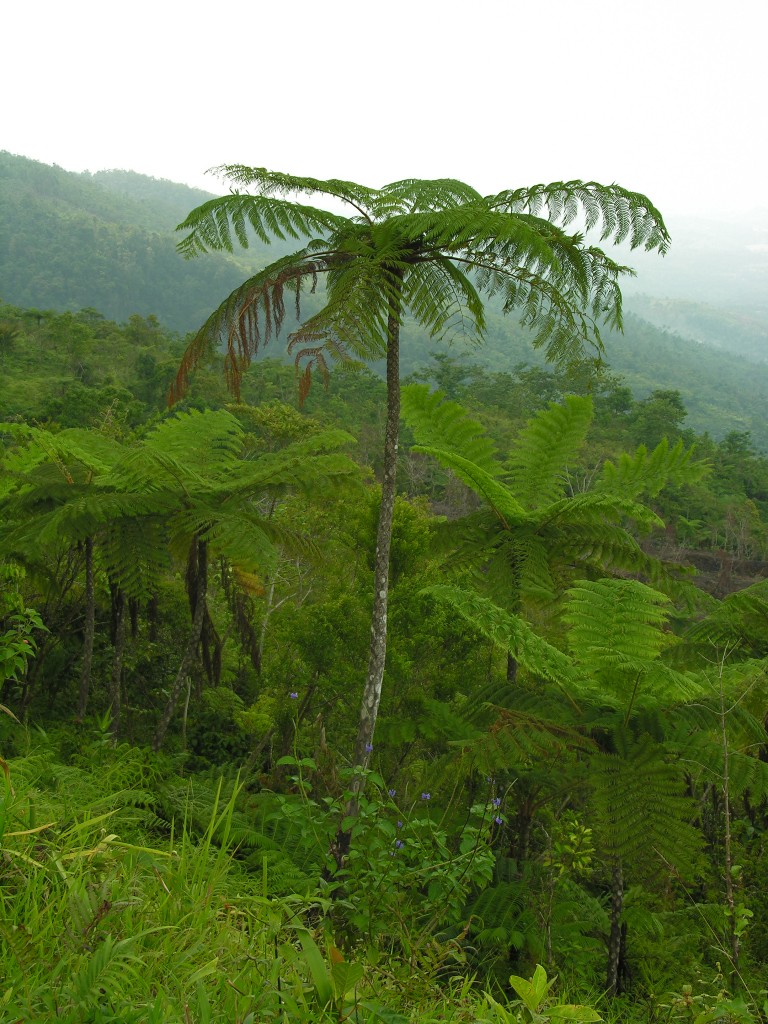.
Cycads and tree ferns represent two ancient groups of plants which evolved before all modern vascular flowering plant species. While superficially similar, cycads and tree ferns are not closely related as shown by their distinct reproductive cycles. Cycads procreate by means of single-sex cones borne on separate plants that bear seeds, whereas tree ferns reproduce by producing spores in common with all other fern species. Cycads produce a large crown of compound, evergreen leaves that is generally borne atop of a stout trunk, and are found across much of the tropical and subtropical regions of the world, most notably South and Central America (where the greatest diversity occurs), Mexico, the Antilles, south-eastern United States of America, Australia, Melanesia, Micronesia, Japan, China, Southeast Asia, India, Sri Lanka, Madagascar, and southern and tropical Africa. In total, there are approximately 305 commonly recognized species of cycads, belonging to 12 genera in 3 families. Although the majority of cycad species are found growing in forest or scrub, generally in strong sunlight, some populate harsh, semi-desert habitats that may be prone to frequent wildfires and drought, and others grow on exposed cliffsides or rooted directly to bare rock. The speed of the growth cycle of differing cycad species various profoundly, many taxa grow relatively quickly, reaching maturity within a few years, whereas others require decades before flowering takes place. Several cycad species exhibit marked longevity; individual plants may survive a century or more both in the wild and in cultivation.
Although they comprise only a minor element of the worlds modern assemblage of flora, during the past, cycads were extremely common and predate many other extant life forms. The cycad fossil record dates back to at least 280 million years ago, and disputed fossil finds suggest early cycads may have existed as long ago as 325 million years before the present. The distribution of extant cycad species strongly suggests that ancestral cycad taxa were widely distributed across the ancient supercontinents Laurasia and Gondwana, prior to the formation of the modern continental landmasses. It was during this time that cycads diversified and spread widely, to the extent that by 57 million years ago, they represented one of the main floral elements of the plant kingdom that existed at that time – a period in botanical history commonly known as the ‘age of cycads’. At this time, cycad-like plants, along with the conifers and Ginkgoales formed extensive forests which covered most of the globe. Cycads therefore not only coexisted with dinosaurs, but predate many dinosaur lineages, and certainly many herbivorous dinosaur species are likely to have fed upon the tough fronds of large cycad species. Fossil cycad pollen dating from this so-called ‘age of the cycads’ is known from every continent and every latitude from Siberia to the Antarctic. All modern (extant) genera of cycads are recognizable as fossils from around 50-60 million years ago. From this time onwards, the fossil record clearly illustrates that cycads were increasingly displaced as plants with more efficient reproductive and dispersal processes gradually became more common, and eventually assumed dominance. Slowly, cycad species were outcompeted and displaced, and the species which persist today may therefore be held to represent the legacy of a great and extremely successful lineage of plants.
Tree ferns similarly comprise a group of ancient fern species in the order Cyatheales that are distinguished by their tendency to produce ascending, woody, trunk-like stems. Most species of tree ferns belong to the families Cyatheaceae (five genera) and Dicksoniaceae (three genera), and in total, at least one thousand species are recognized from across the world today. The majority of extant tree fern species are found growing in tropical and subtropical forested areas, as well temperate rainforests in Australia, New Zealand, and other island groups nearby; a few genera extend further, such as Culcita in southern Europe. A large number of species are restricted to very small ranges on islands or at higher elevations, often on isolated mountaintops. The cause for the generally high rates of endemism of the tree ferns of the world remains unknown. Most fern species are widely distributed owing to their reproduction cycle involving minute, wind-blown spores, however this is rarely the case for tree ferns. The largest tree fern species produce erect trunks up to 25 metres tall, but in most species, much shorter stems are produced. Much like cycads, the growing tip produces a rosette of evergreen foliage, often consisting of highly divided leaves that may reach several metres in length.
Fossil evidence of tree ferns extends back to at least 200 million before present. Species of Cyatheaceae and Dicksoniaceae appear to have been diverse and relatively common from 150 million years ago onwards, however fossilized remains of the modern genera only become evident from 65 million years ago onwards, suggesting speciation of tree ferns took place considerably in comparison to cycads. The abrupt shifts in the tree fern species from 65 million years ago onwards is widely interpreted as evidence that tree ferns were influenced by the mass extinction event recorded across nearly all groups of organisms at the close of the Cretaceous Period. From that time to the present, tree ferns have increasingly adapted and diversified to compete with the modern assemblages of flowering plants which have evolved during relatively recent times.
Both cycads and tree ferns are increasingly threatened across the world by the activities of mankind. 23% of the 305 extant cycad species are either critically endangered or endangered, and 15% are considered vulnerable. Many species of tree ferns have already been rendered extinct, and dozens are listed as endangered. Both groups remain threatened because they are desirable among horticulturists, and commonly harvested in large scales. Wild-collected cycads and tree ferns are widely available across the world and are sold as pot plants, often fetching high prices. The unsustainable collection of cycads and tree ferns, combined with their relatively slow reproductive cycles and general incapability to survive major habitat destruction often translates to swift population decline.
Stewart McPherson
